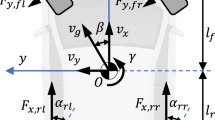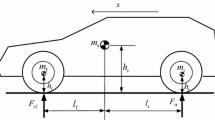Abstract
With the real time and accurate information of motor torque and rotation speed of the four-in-wheel-motordrive electric vehicles, a slip based algorithm for estimating maximum road friction coefficient is designed using Lyapunov stability theory. Modified Burckhardt tire model is used to describe longitudinal slip property of the tire. By introducing a new state variable, a nonlinear estimator is proposed to estimate the longitudinal tire force and the maximum road friction coefficient simultaneously. With the appropriate selection of estimation gain, the convergence of the estimation error of the tire longitudinal force and maximum road friction coefficient is proved through Lyapunov stability analysis. In addition, the error is exponentially stable near the origin. Finally the method is validated with Carsim-Simulink co-simulation and real vehicle tests under multi working conditions in acceleration situation which demonstrate high computational efficiency and accuracy of this method.
Similar content being viewed by others
References
Ahn, C., Peng, H. and Tseng, H. E. (2012). Robust estimation of road friction coefficient using lateral and longitudinal vehicle dynamics. Veh. Syst. Dyn. 50, 6, 961–985.
Ahn, C., Peng, H. and Tseng, H. E. (2013). Robust Estimation of Road Frictional Coefficient. IEEE Trans. Control Systems Technology 21, 1, 1–13.
Alvarez, L., Yi, J., Horowitz, R. and Olmos, L. (2004). Dynamic friction modelbased tire-road friction estimation and emergency braking control. J. Dyn. Syst., Meas., Control 127, 1, 22–32.
Burckhardt, M. (1993). Vehicle Chassis Technology-Wheel Sub System. Wurtzburg: Vogel-Verlag.
Chen, L., Bian, M., Luo, Y. and Li, K. (2015). Real-time identification of the tyre–road friction coefficient using an unscented Kalman filter and mean-square-errorweighted fusion. Proc. IMechE Part D: J. Automobile Engineering, 1–15.
Chen, Y. and Wang, J. (2011). Adaptive vehicle speed control with input injections for longitudinal motion independent road frictional condition estimation. IEEE Trans. Vehicular Technology 60, 3, 839–848.
Choi, M., Oh, J. and Choi, S. (2013). Linearized recursive least squares methods for real-time identification of tire–Road friction coefficient. IEEE Trans. Vehicular Technology 62, 7, 2906–2918.
Erdogan, G., Alexander, L. and Rajamani, R. (2011). Estimation of tire-road friction coefficient using a novel wireless piezoelectric tire sensor. IEEE Sensors J. 11, 2, 267–279.
Grip, H. F., Johansen, T. A., Imsland, L. and Kaasa, G. (2010). Parameter estimation and compensation in systems with nonlinearly parameterized perturbations. Automatica 46, 1, 19–28.
Gustafsson, F. (1997). Slip-based tire-road friction estimation. Automatica 33, 6, 1087–1099.
Haffner, L., Kozek, M., Shi, J. and Jorgl, H. P. (2008). Estimation of the maximum friction coefficient for a passenger vehicle using the instantaneous cornering stiffness. American Control Conf., Seattle, Washington, USA.
Hori, Y. (2004). Future vehicle driven by electricity and control-research on four-wheel-motored “UOT electric march II”. IEEE Trans. Industrial Electronics 51, 5, 954–962.
Imsland, L., Fossen, T. I., Johansen, T. A., Grip, F. G., Kalkkuhl, J. C. and Suissa, A. (2006). Vehicle velocity estimation using nonlinear observers. Automatica 42, 12, 2091–2103.
Jin, C., Xiong, L., Yu, Z. and Feng, Y. (2014). Path following control for skid steering vehicles with vehicle speed adaption. SAE Paper No. 2014-01-0277.
Khalil, H. K. (2002). Nonlinear Systems. Prentice-Hall. Upper Saddle River, New Jersey, USA.
Krstic, M., Kanellakopoulos, I. and Kokotovic, P. V. (1995). Nonlinear and Adaptive Control Design. Wiley. New York.
Li, K., Misener, J. A. and Hedrick, K. (2007). On-board road condition monitoring system using slip-based tyreroad friction estimation and wheel speed signal analysis. Proc. Institution of Mechanical Engineers Part K: J. Multi-body Dynamics 221, 1, 129–146.
Li, L., Jia, G., Song, J. and Ran, X. (2013). Progress on vehicle dynamics stability control system. Chinese J. Mechanical Engineering 49, 24, 95–107.
Li, L., Wang, F. Y. and Zhou, Q. (2006). Integrated longitudinal and lateral tire/road friction modeling and monitoring for vehicle motion control. IEEE Trans. Intelligent Transportation Systems 7, 1, 1–19.
Li, L., Yang, K., Jia, G., Song, J. and Han, Z.-Q. (2015). Comprehensive tire-road friction coefficient estimation based on signal fusion method under complex maneuvering operations. Mechanical Systems and Signal Processing, 56-57, 259–276.
Li, L., Zhu, H., Chen, J., Song, J. and Ran, X. (2014). Road Friction identification algorithm for the vehicle stability control. Chinese J. Mechanical Engineering 50, 2, 132–138.
Lin, F. and Huang, C. (2013). Unscented Kalman filter for road friction coefficient estimation. J. Harbin Institute of Technology University 45, 7, 115–120.
Matuško, J., Petrovic, I. and Peric, N. (2007). Neural network based tire/road friction force estimation. Engineering Applications of Artificial Intelligence 21, 3, 442–456.
Müller, S., Uchanski, M. and Hedrick, K. (2004). Estimation of the maximum tire-road friction coefficient. J. Dyn. Syst., Meas., Control 125, 4, 1–11.
Patel, N., Edwards, C. and Spurgeon, S. K. (2008). Tyreroad friction estimation-A comparative study. Proc. IMechE Part D: J. Automobile Engineering 222, 12, 2337–2351.
Pohl, A., Steindl, R. and Reindl, L. (1999). The intelligent tire utilizing passive SAW sensors measurement of tire friction. IEEE Trans. Instrumentation and Measurement 48, 6, 1041–1046.
Qi, Z., Taheri, S., Wang, B. and Yu, H. (2015). Estimation of the tyre–Road maximum friction coefficient and slip slope based on a novel tyre model. Veh. Syst. Dyn. 53, 4, 506–525.
Rajamani, R. (2005). Vehicle Dynamics and Control. Springer-Verlag. New York.
Rajamani, R., Piyabongkarn, D., Lew, J. Y., Yi, K. and Phanomchoeng, G. (2010). Tire-road friction-coefficient estimation. IEEE Control Systems 30, 4, 54–69.
Rath, J. J., Veluvolu, K. C., Defoort, M. and Soh, Y. C. (2014). Higher-order sliding mode observer for estimation of tyre friction in ground vehicles. IET Control Theory and Applications 8, 6, 399–408.
Ray, L. R. (1997). Nonlinear tire force estimation and road friction identification: Simulation and experiments. Automatica 33, 10, 1819–1833.
Sato, Y., Kobay, A. D., Kageyama, I., Watanabe, K., Kuriyagawa, Y. and Kuriyagawa, Y. (2007). Study on recognition method for road friction condition. JSAE Trans., 38, 51–56.
Singh, A. and Khalil, H. K. (2005). Regulation of nonlinear systems using conditional integrators. Int. J. Robust Nonlinear Control 15, 8, 339–362.
Sun, F., Huang, X., Rudolph, J. and Lolenko, K. (2015). Vehicle state estimation for anti-lock control with nonlinear observer. Control Eng. Practice, 43, 69–84.
Van, Z. (2000). Bosch ESP systems: 5 years of experience. SAE Paper No. 2000-01-1633.
Wang, X., Xiong, L. and Jin, C. (2014). A control strategy for slip regulation coordinated with driver intention. Applied Mechanics & Materials, 556-562, 4045–4050.
Wit, C. C., Horowitz, R. and Tsiotras, P. (2007). Modelbased observers for tire/road contact friction prediction. Lecture Notes in Control and Information Sciences, 244, 23–42.
Xu, S., Yu, Z. and Xiong, L. (2015). Control of novel integrated-electro-hydraulic brake system for automotive. SAE Paper No. 2015-01-2699.
Yu, Z., Feng, Y. and Xiong, L. (2013). Review on vehicle dynamics control of distributed drive electric vehicle. Chinese J. Mechanical Engineering 49, 8, 105–114.
Yu, Z., Zuo, J. and Zhang, L. (2006). A summary on the development status quo of tire-road friction coefficient estimation techniques. Automotive Engineering 28, 6, 546–549.
Author information
Authors and Affiliations
Corresponding author
Rights and permissions
About this article
Cite this article
Xia, X., Xiong, L., Sun, K. et al. Estimation of maximum road friction coefficient based on Lyapunov method. Int.J Automot. Technol. 17, 991–1002 (2016). https://doi.org/10.1007/s12239-016-0097-7
Received:
Revised:
Accepted:
Published:
Issue Date:
DOI: https://doi.org/10.1007/s12239-016-0097-7




